

John Brough
Allen Smith Jr. (1810, Rhode Island - 1890, Cleveland, Ohio) was an American portrait painter. He also created some landscapes and genre scenes.


Allen Smith Jr. (1810, Rhode Island - 1890, Cleveland, Ohio) was an American portrait painter. He also created some landscapes and genre scenes.
He grew up in Massachusetts. Later, he went to New York, where he studied with the miniaturist, William Daniel Parisen (1800-1849), while attending antique classes at the American Academy of the Fine Arts. He attended similar classes at the National Academy of Design and continued to exhibit there occasionally from 1832 to 1842. He was an Associate Member until 1860. [1]
In 1835, he joined his parents in Detroit. Three years later, he was in Cincinnati, then returned to New York for a short time, finally settling in Cleveland sometime around 1842. [1] He soon established himself as a popular portrait painter. As a father of eight children, he would often find it necessary to supplement his income by touching up and colorizing photographs for local studios. Following the Panic of 1857, he took a permanent position at the firm of James Fitzallen Ryder (1826-1904), and produced the "best oil painted photographs in Ohio". [2]
He also painted genre scenes, and submitted several to the National Academy and the American Art Union throughout the 1840s and 50s. Only one, "The Young Mechanic" is currently known. [3]
He retired to Lake County in 1882 and devoted his time to painting landscapes in Big Creek Valley. [2]
Some sources credit him as the designer of the first flag of the State of Michigan, which featured a portrait of Governor Stevens T. Mason. [2] None of these flags, or images of them, are known to exist.

Emanuel Gottlieb Leutze was a German-American history painter best known for his 1851 painting Washington Crossing the Delaware. He is associated with the Düsseldorf school of painting.

Albert Bierstadt was a German-American painter best known for his lavish, sweeping landscapes of the American West. He joined several journeys of the Westward Expansion to paint the scenes. He was not the first artist to record the sites, but he was the foremost painter of them for the remainder of the 19th century.
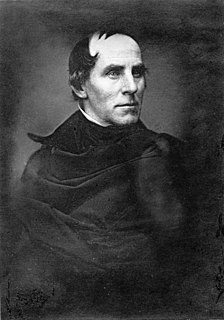
Thomas Cole was an English-American painter known for his landscape and history paintings. He is regarded as the founder of the Hudson River School, an American art movement that flourished in the mid-19th century. Cole's work is known for its romantic portrayal of the American wilderness.

William Powell Frith was an English painter specialising in genre subjects and panoramic narrative works of life in the Victorian era. He was elected to the Royal Academy in 1853, presenting The Sleeping Model as his Diploma work. He has been described as the "greatest British painter of the social scene since Hogarth".
Henriette Wyeth Hurd was an American artist noted for her portraits and still life paintings. The eldest daughter of illustrator N.C. Wyeth, she studied painting with her father and brother Andrew Wyeth at their home and studio in Chadds Ford, Pennsylvania.
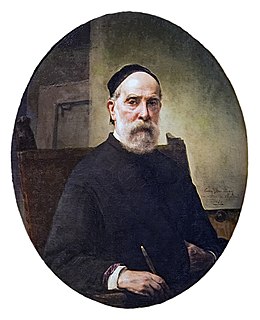
Francesco Hayez was an Italian painter. He is considered one of the leading artists of Romanticism in mid-19th-century Milan, and is renowned for his grand historical paintings, political allegories, and portraits.

James Clarke Hook was an English painter and etcher of marine, genre and historical scenes, and landscapes.
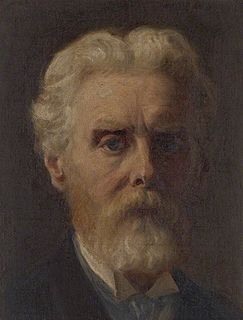
James Archer RSA, was a Scottish painter of portraits, genre works, landscapes and historical scenes.
Sophie Gengembre Anderson was a French-born British artist who specialised in genre painting of children and women, typically in rural settings. She began her career as a lithographer and painter of portraits, collaborating with Walter Anderson on portraits of American Episcopal bishops. Her work, Elaine, was the first public collection purchase of a woman artist. Her painting No Walk Today was purchased for more than £1 million.

The Art Academy of Cincinnati is a private college of art and design in Cincinnati, Ohio, accredited by the National Association of Schools of Art and Design. It was founded as the McMicken School of Design in 1869, and was a department of the University of Cincinnati, and later in 1887, became the Art Academy of Cincinnati, the museum school of the Cincinnati Art Museum.

Robert Seldon Duncanson was a 19th-century American landscapist of European and African ancestry. Inspired by famous American landscape artists like Thomas Cole, Duncanson created renowned landscape paintings and is considered a second generation Hudson River School artist. Duncanson spent the majority of his career in Cincinnati, Ohio and helped develop the Ohio River Valley landscape tradition. As a free black man in antebellum America, Duncanson engaged the abolitionist community in America and England to support and promote his work. Duncanson is considered the first African-American artist to be internationally known. He operated in the cultural circles of Cincinnati, Detroit, Montreal, and London. The primary art historical debate centered on Duncanson concerns the role that contemporary racial issues played in his work. Some art historians, like Joseph D. Ketner, believe that Duncanson used racial metaphors in his artwork, while others, like Margaret Rose Vendryes, discourage viewers from approaching his art with a racialized perspective.

Henry Inman was an American portrait, genre, and landscape painter.

John Mix Stanley was an artist-explorer, an American painter of landscapes, and Native American portraits and tribal life. Born in the Finger Lakes region of New York, he started painting signs and portraits as a young man. In 1842 he traveled to the American West to paint Native American life. In 1846 he exhibited a gallery of 85 of his paintings in Cincinnati and Louisville. During the Mexican–American War, he joined Colonel Stephen Watts Kearney's expedition to California and painted accounts of the campaign, as well as aspects of the Oregon Territory.

Robert Walker Macbeth was a Scottish painter, etcher and watercolourist, specialising in pastoral landscape and the rustic genre. His father was the portrait painter Norman Macbeth and his niece Ann Macbeth. Two of his five brothers, James Macbeth (1847–1891) and Henry Macbeth, later Macbeth-Raeburn (1860–1947), were also artists.

Joseph Henderson (1832–1908) was a Scottish landscape painter, genre painter, portrait painter and marine painter. His genre was particularly painting working men such as shepherds, crofters, pedlars, cobblers, fishermen and farm labourers. However he also painted Scottish country and coastal scenery.

Alfred Jacob Miller was an American artist best known for his paintings of trappers and Native Americans in the fur trade of the western United States. He also painted numerous portraits and genre paintings in and around Baltimore during the mid-nineteenth century.

Kilian Christoffer Zoll was a Swedish painter, graphic artist and illustrator in the style of the Düsseldorf School. He created genre scenes, landscapes, altarpieces and portraits.
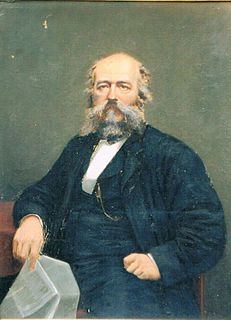
Charles Allen Duval, often spelled duVal or Du Val,, was a well-known Victorian portrait painter, photographer, literary critic, illustrator and writer. He played a large role within the city of Manchester's thriving art scene, including the Manchester Academy of Fine Arts, the Manchester City Art Gallery and the Art Treasures Exhibition, Manchester 1857: a scene which was underpinned by Manchester's industrial entrepreneurs and politicians who all flocked to his studio to have their portraits painted.
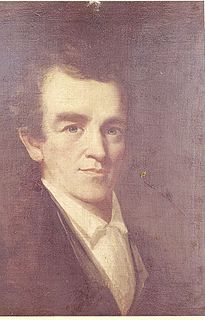
James Bowman was an American itinerant artist and portrait painter. He was born in Allegheny County, Pennsylvania near Pittsburgh. Sometime between 1813 and 1815, James Bowman went to Chillicothe, Ohio, to learn to be a carpenter. There he met the itinerant painter Mr. J. T. Turner who taught him the rudiments of portrait painting. He gained considerable success when he started out professionally, painting in Pittsburgh and other communities in the early 1820s. He traveled to Philadelphia to learn from the masters there, but as a beginning artist could not make a living in that more cosmopolitan and competitive environment and became an itinerant portrait painter instead.

Addison Thomas Millar was an American painter and artist; best known for his genre scenes and Orientalist paintings.
![]() Media related to Allen Smith, Jr. at Wikimedia Commons
Media related to Allen Smith, Jr. at Wikimedia Commons